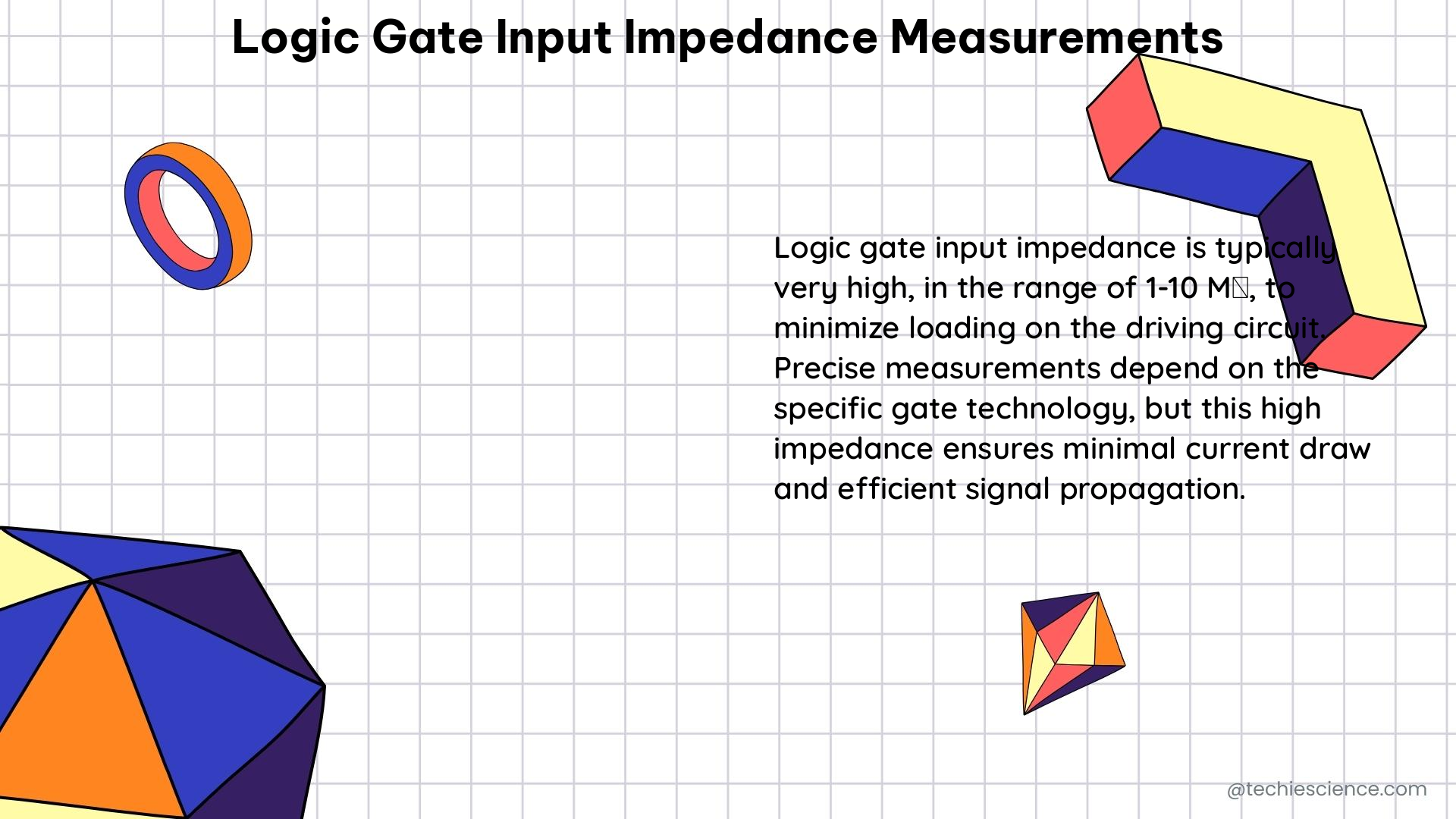Logic gate input impedance measurements are crucial in determining the compatibility and performance of digital circuits. The input impedance of a logic gate refers to the opposition offered by the gate’s input to the flow of current, typically measured in ohms (Ω) and typically in the megohm range for CMOS and BiCMOS devices.
Understanding the Importance of Input Impedance
The input impedance of a logic gate can significantly impact the signal integrity and the overall functionality of a digital circuit. High input impedance helps minimize power consumption and signal degradation, ensuring efficient signal transmission. Conversely, low input impedance can lead to increased power consumption, signal distortion, and potential damage to the driving circuit.
Measuring Logic Gate Input Impedance

Measuring the input impedance of a logic gate involves applying a known input signal and measuring the resulting current and voltage. The input impedance can then be calculated using Ohm’s law (Z=V/I). Various methods and tools can be used for these measurements, including:
- Network Analyzers: Network analyzers can be used to measure the input impedance of logic gates by applying a known input signal and measuring the resulting voltage and current.
- Oscilloscopes: Oscilloscopes can be used to measure the input impedance of logic gates by applying a known input signal and measuring the resulting voltage and current waveforms.
- Specialized Software: Tools like the QA401 speaker impedance plug-in can be used to measure the input impedance of logic gates. This method involves using a sense resistor to measure the voltage across the input, with the resulting data processed and analyzed using the QA401 software.
Factors Affecting Input Impedance Measurements
When measuring the input impedance of a logic gate, it is essential to consider the impact of external factors such as:
- Load Resistance: The load resistance connected to the logic gate can affect the input impedance measurements. It is important to ensure that the load resistance is appropriate for the specific logic gate being tested.
- Cable Length: The length of the cables used to connect the logic gate to the measurement equipment can also affect the input impedance measurements. Longer cables can introduce parasitic capacitance and inductance, which can impact the accuracy of the measurements.
- Signal Frequency: The frequency of the input signal used for the measurements can also affect the input impedance. Higher frequencies may result in different input impedance values due to the frequency-dependent nature of the gate’s input characteristics.
Considering Input and Output Stage Characteristics
When measuring the input impedance of a logic gate, it is crucial to consider both the input and output stage characteristics of the gate. The input stage of a logic gate determines its input characteristics, with high impedance being a common feature of CMOS and BiCMOS devices. This high impedance helps minimize power consumption and signal degradation, ensuring efficient signal transmission.
However, the output stage of a logic device in the high logic state behaves like a voltage source with an open-circuit voltage of VCC for CMOS logic or low-voltage BiCMOS logic. The internal resistance for the high state is inversely proportional to the drive capability of the device, which can affect the input impedance of the following stage.
Therefore, when measuring the input impedance of a logic gate, it is crucial to consider both the input and output stage characteristics to ensure accurate and meaningful measurements. This holistic approach can help optimize signal integrity, power consumption, and overall circuit performance, leading to more efficient and reliable digital systems.
Practical Considerations and Best Practices
When conducting logic gate input impedance measurements, it is essential to follow these best practices:
- Calibrate Measurement Equipment: Ensure that the measurement equipment, such as network analyzers or oscilloscopes, are properly calibrated to provide accurate and reliable results.
- Use Appropriate Probes: Select probes that are compatible with the logic gate and the measurement equipment, and ensure that they are properly connected to minimize signal distortion and interference.
- Minimize Parasitic Effects: Take steps to minimize the impact of parasitic capacitance and inductance, such as using short and shielded cables, and ensuring proper grounding of the measurement setup.
- Perform Multiple Measurements: Conduct multiple measurements to ensure the consistency and reliability of the results, and to identify any potential sources of error or variability.
- Document Measurement Conditions: Record the measurement conditions, such as the input signal frequency, load resistance, and environmental factors, to ensure that the results can be properly interpreted and compared to other measurements.
Conclusion
Logic gate input impedance measurements are a critical aspect of digital circuit design and analysis. Understanding the input impedance of a logic gate can help optimize signal integrity, power consumption, and overall circuit performance. By considering the input and output stage characteristics of the logic gate, as well as the impact of external factors, you can conduct accurate and meaningful measurements that will lead to more efficient and reliable digital systems.
Reference Links:
- Measuring Input Impedance – QuantAsylum
- Input and Output Characteristics of Digital Integrated Circuits at 2.5 V …
- Turning a high impedance output state to a concrete voltage value …
- Electrochemical Impedance Spectroscopy – A Tutorial
- How Impedance Influences Measurements

The lambdageeks.com Core SME Team is a group of experienced subject matter experts from diverse scientific and technical fields including Physics, Chemistry, Technology,Electronics & Electrical Engineering, Automotive, Mechanical Engineering. Our team collaborates to create high-quality, well-researched articles on a wide range of science and technology topics for the lambdageeks.com website.
All Our Senior SME are having more than 7 Years of experience in the respective fields . They are either Working Industry Professionals or assocaited With different Universities. Refer Our Authors Page to get to know About our Core SMEs.